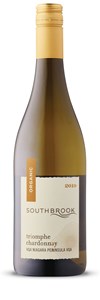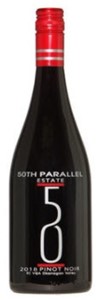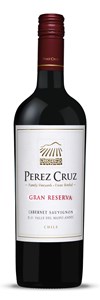Today is World Architecture Day, so we’re raising a glass to some of the most iconic wineries around the world. Here to share the best in wine design is Natalie MacLean who offers Canada’s most popular online wine classes at nataliemaclean.com.
Welcome Natalie.
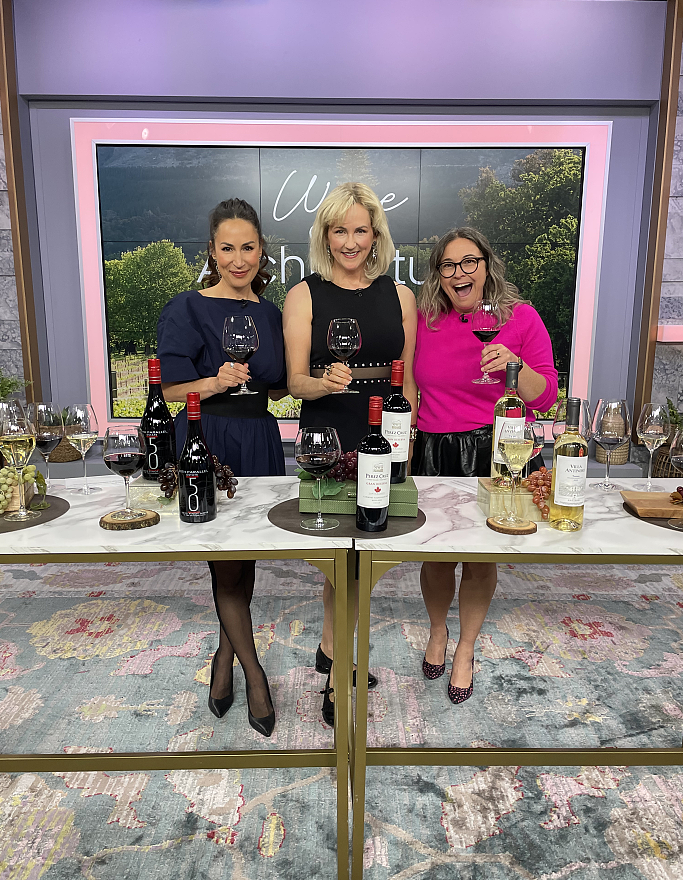
Great to be here with you. In both architecture and wine, structure is everything – though I prefer my wine’s structure to be a little more fluid than my buildings.
Beyond a beautiful building, why does winery architecture matter?
Many wineries these days are more than just pretty castles with tasting rooms. They’re designed to reflect and respect their environment as well as to treat the grapes gently in order to make better wine. Several of those we’ll showcase today have been created by some of the world’s best architects.

Wow! Where are we starting?
We’ll start right here in Ontario with Southbrook Vineyards in Niagara-on-the-Lake. The architect, Jack Diamond, designed the Four Seasons Opera House in Toronto before taking on the Southbrook project in 2007.
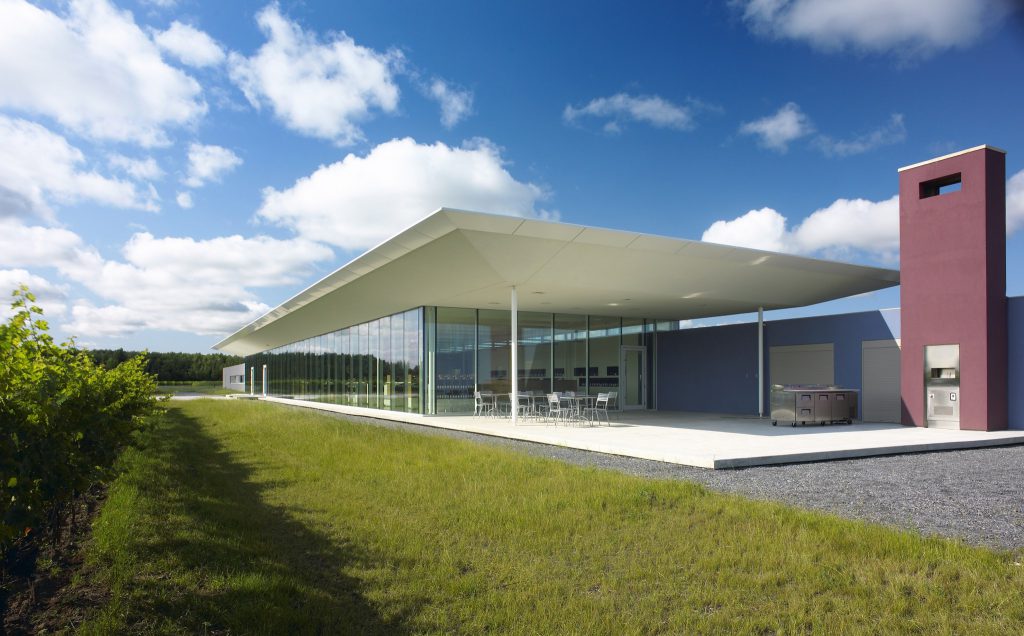
Southbrook is the first LEED gold winery in Canada. It’s a prestigious international designation that stands for Leadership in Energy and Environmental Design and is awarded to buildings that have achieved a high level of sustainability in their design and operation. Southbrook also has Canada’s first Demeter certification for biodynamic viticulture.
What was the inspiration for the design?
Husband-and-wife Bill and Marylin Redelmeier wanted Southbrook to sit lightly on the land. They took inspiration from Frank Lloyd Wright’s Prairie School of architecture with its emphasis on nature and simplicity.
Every space in the building looks out into the vineyard with full floor to ceiling windows, well, except the bathrooms 😉 The light flooding into the building makes it a happy, joyful place.
Nothing in the building is more than shoulder height because that would block the view. It’s designed to make you feel as though you are in the vineyard, as though the vines are inviting you to come out and play.
Wow! So what are we tasting from Southbrook?
We have the Southbrook Vineyards Triomphe Chardonnay, a vegan-friendly wine made from organically grown grapes. It’s dry, zesty and full-bodied, with aromas of ripe yellow apple and pear, and a rich, creamy palate.
Imagine sipping on this lovely wine as you gaze out into the vineyards, perhaps nibbling on a crusty baguette slathered with a creamy brie.
Southbrook Vineyards Triomphe Chardonnay
Niagara Peninsula, Ontario V.Q.A., Canada
Where are you taking us next?
We’re heading west next to the 50th Parallel Estate Winery in BC’s Okanagan Valley. The winery sits on the 50th parallel, the same latitude as several of Europe’s top vineyards. Husband-and-wife Curtis Krouzel and Sheri-Lee Turner-Krouzel wanted the design to be in parallel with its environment, as though it grew out of the land itself.
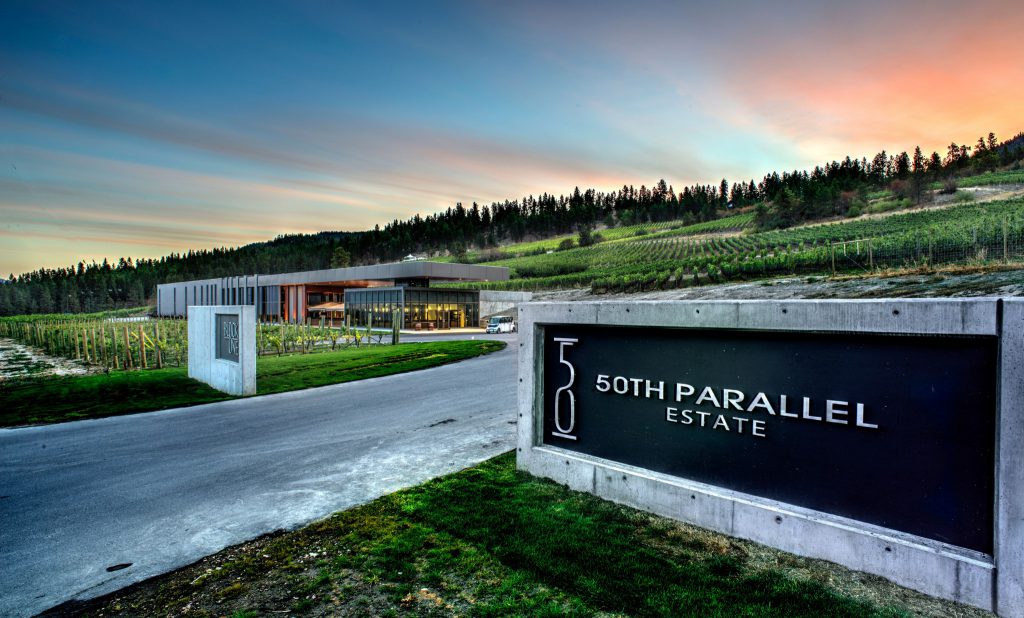
So they worked with Calgary architect Tim Sahuri to build a 700-foot linear winery over 10 years. The building is recessed into the land so it would have a low visual impact on the valley. It has since won the prestigious International Design Award in Los Angeles.
How does the design affect the perception and feeling of visiting the winery?
The winery has a cantilevered roof line that gives the impression that the building is floating with nothing supporting it. The top-rated Block One restaurant has a two-story water feature and massive wood columns.
The all-glass Transparent Tasting Room overlooks Lake Okanagan. Both are open year-round. There are more than 150,000 square feet indoors and outside so the goal was to create the feeling of being lost in the beauty of an expansive building without actually losing anyone. Though I guess they can’t be 100% sure of that 😉
What was the goal for the winery design?
Producing world-class Pinot Noir was the first goal of the building. Pinot Noir wants to become vinegar faster than any other grape. It’s thin-skinned, high maintenance, very diva.
That’s why the design is gravity-flow: as the grapes move from winemaking step to the next, they move gently downward rather than being forcibly pumped up or getting exposed to too much oxygen, like turning harsh lights on your a-list movie star. Don’t do it; it won’t end well.
Which wine are we tasting from the 50th Parallel?
You have their gorgeous estate Pinot Noir. The 50th Parallel estate has some of the most light-infused vineyards on the planet with the reflected light from Lake Okanagan.
50th Parallel Estate Pinot Noir
Okanagan Valley, BC V.Q.A., Canada
That’s ideal for Pinot to develop these gorgeous aromas of ripe cherry, field berries and a kiss of spice. Curtis curates the wine club selections and they ship across Canada to your doorstep, as does Southbrook. Go for the architecture; stay for the wine.
Lovely! Where are we going next?
We’re traveling south to Chile to visit Pérez Cruz, nestled at the foot of the Andes Mountains. This winery is built from native woods and its exterior arches allow air flow through the structure evoking the wind passing through trees.
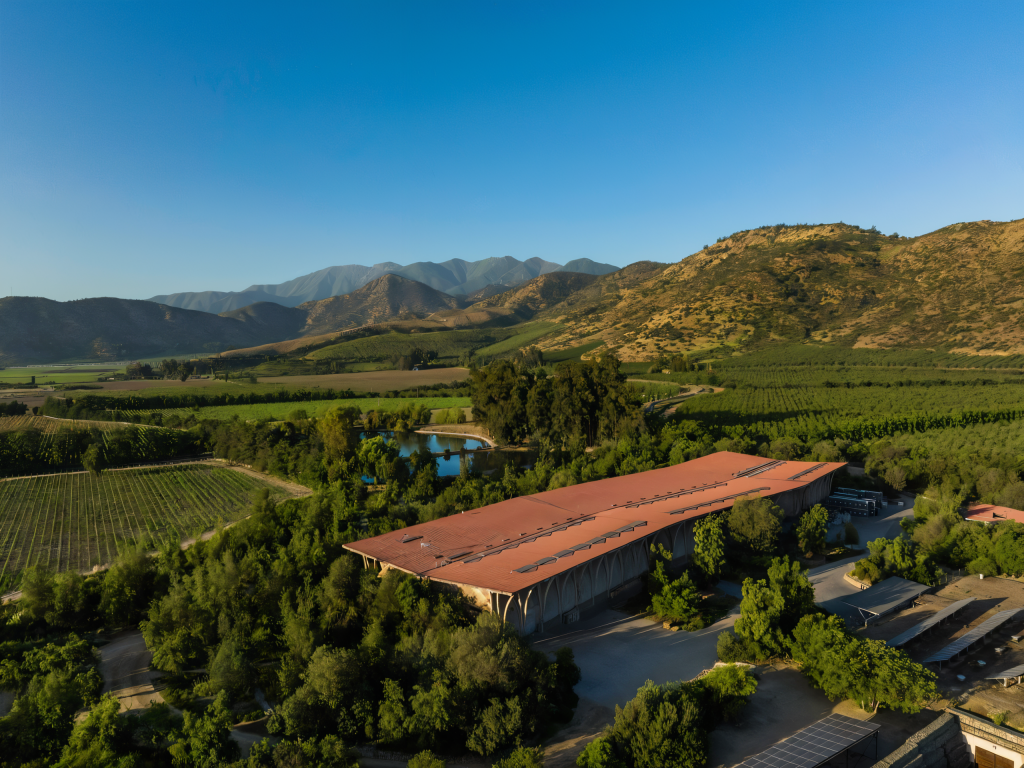
The stone foundations recall the structures the Incas left behind in this area. When you’re standing there, surrounded by all that glass and wood, you realize that great architecture—like great wine—makes you feel connected to something larger than yourself. The building won the Spirit of Nature Architecture Award.
How does this winery make use of its surroundings?
The expressively curved pinewood supports the flying roof and blends in with the setting. Seen from a distance, it looks almost tent-like and ethereally light. Its sustainable design that follows the road line also incorporates a gravity-flow winemaking process.
The underground cellar temperature and humidity are controlled naturally without refrigeration systems, reducing its environmental impact.
What are we tasting?
We have the Perez Cruz Gran Reserva Cabernet Sauvignon, a smooth, full-bodied red with aromas of ripe blackberry, dark plum and a whisper of smoke. It has a long, satisfying finish that’s perfect for hearty meat dishes and hard cheeses.
Perez Cruz Gran Reserva Cabernet Sauvignon
Maipo Valley, Chile
What’s next?
We’re flying over to Italy to visit Antinori nel Chianti Classico winery. Florentine architect Marco Casamonti took his inspiration from the Tuscan countryside. The circular contemporary design blends seamlessly into the rolling rural landscape with its reddish-brown earth tones and natural building materials of terracotta.
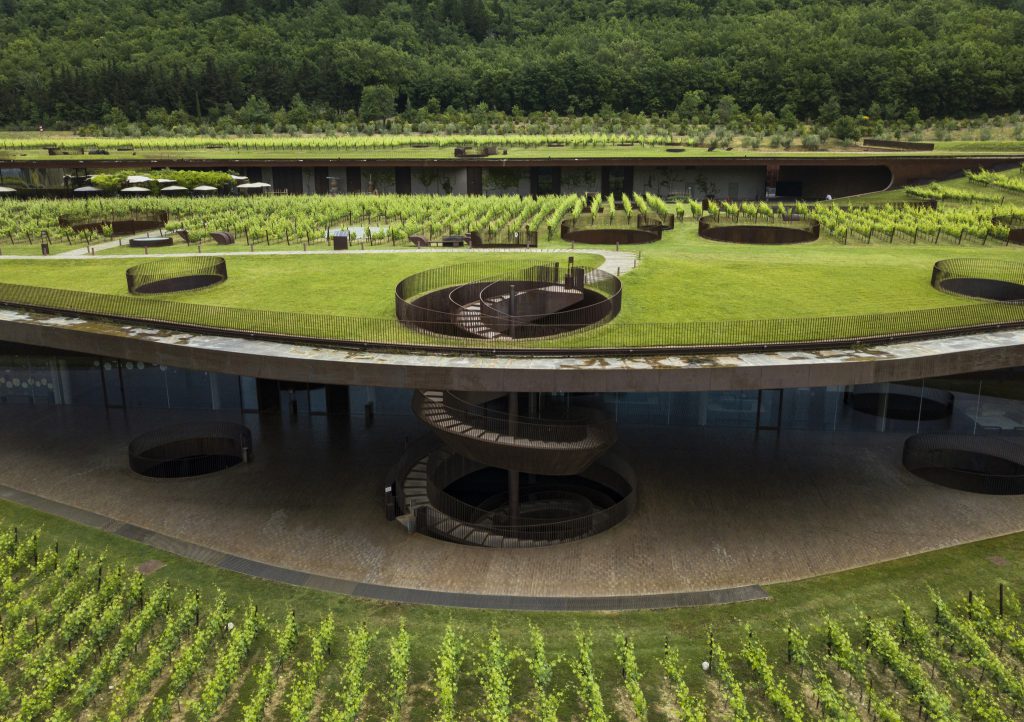
How does the design impact the wine?
The winery is covered by 11.4 acres of vineyards, which makes it practically invisible. Sangiovese vines grow directly on the rooftop, blanketing the winery like a cloak merging it into the surrounding landscape.
The building’s three levels are connected by a spectacular spiral staircase. This is also a gravity-flow facility with a naturally cool cellar. It’s a fusion of architecture and nature, nestled among olive groves and oak forests.
What are we tasting?
You have the Villa Antinori Bianco Toscana is a crisp, refreshing white wine with notes of lime zest and lemon sunshine. It would be perfect with fresh seafood.
Villa Antinori Bianco
Tuscany, Italy
What’s our final destination?
We’re heading to Spain to visit the Marques de Riscal winery, built in 1860 as a traditional sandstone bodega in a medieval Rioja town.
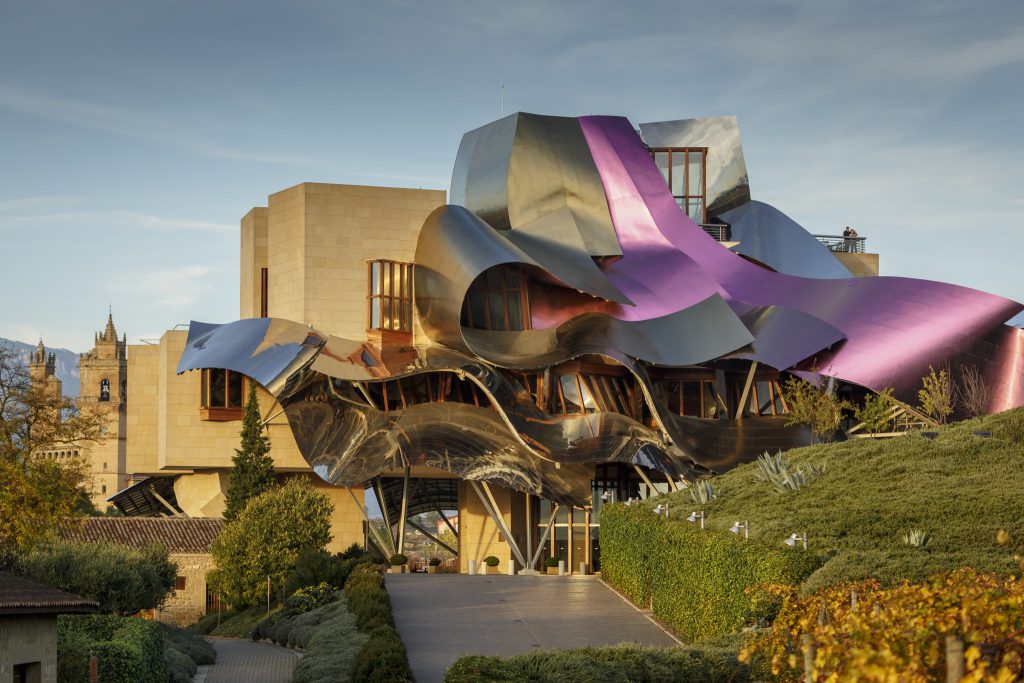
In 2006, they opened the Hotel Marqués de Riscal, designed by the renowned Canadian architect Frank Gehry who also designed New York City’s Guggenheim Museum Bilbao.
Tell us about the construction.
There’s more than 3,400 square metres of exterior ribboned titanium panels and steel roofs. It looks like the flounces of a Flamenco dancer’s dress is gently sweeping over the vines.
What’s remarkable is the way this avant-garde architecture blends with the historic buildings. It’s a dance between the past and the future with the wine as well: respect traditional winemaking while incorporating modern technology and ideas.

What are we tasting?
Marques de Riscal Rioja Reserva is a smooth, full-bodied red with aromas of dark fruit and dusty, earthy notes. I’d love to pair this with lamb and rosemary.
Marques De Riscal Rioja Reserva
Rioja D.O.C., Spain
Do you have any final observations?
Wine and design are a natural blend since both are influenced by place: the soil, the climate and the contours of the land. Each tells a story about the dreams and tastes of the people who created it. Let’s raise a glass to those who design for both purpose and pleasure!

Thank you, Natalie. We’ll be right back after this.
You can get my free Ultimate Food and Wine Pairing guide here: nataliemaclean.com/guide


